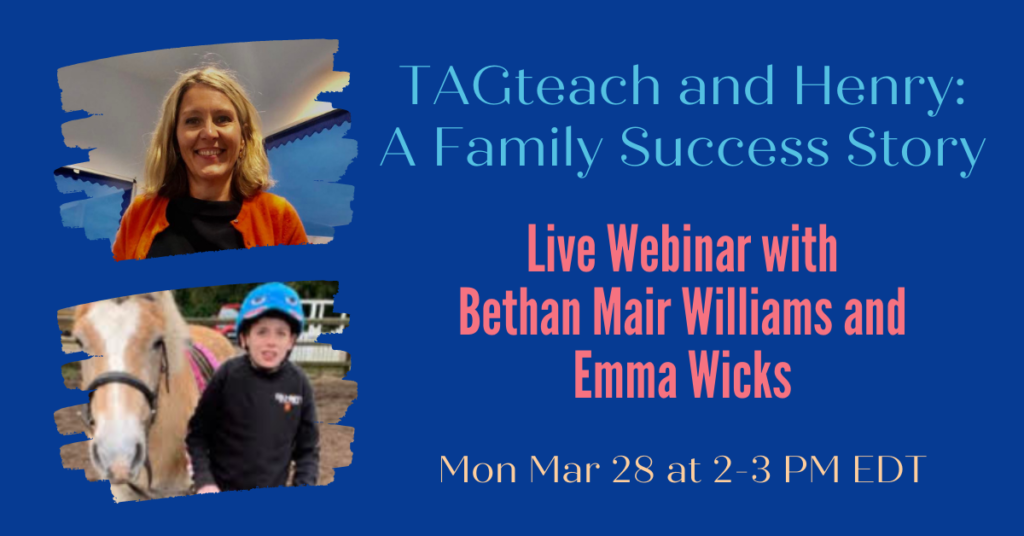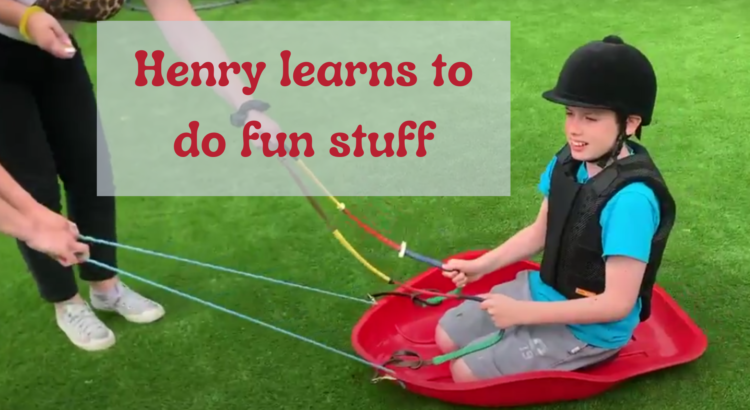By Emma Wicks
My son Henry (now 11) was diagnosed with autism at the age of two and a half. Despite his complex needs and communication difficulties, TAGteach has been a simple yet effective tool for Henry and his family and tutors to help pinpoint the precise movements that enable him to get the most out of his hobbies, school, and day to day routines.
Happiness for Henry was Paramount
Like all parents, I wanted Henry to gain the skills needed to enjoy an independent, fulfilling, and happy life. With complex special educational needs (SEN), this throws up some challenges both for the child with SEN and the parent. I qualified as a Montessori teacher in 2013 and believed in the importance of following a child’s interests and allowing them time to discover, explore and just ‘be’.
Henry did not however pick up speech from the communication rich environment, absorbing songs and engaging in face-to-face interactions which I (and many others) took great pains to set up for him. He would turn his back, preferring to scatter beads instead of thread them, taste the paint instead of dip his fingers or brush into it and run freely. None of this free exploration was discouraged, (save for the paint!). Yet I still needed a way to help him to learn the skills he would need for an independent life: the ability to communicate what he wants and what he needs, the academic skills to read and write and understand numbers and quantities, the everyday living skills to cook, clean and tidy and the self-care skills for washing, drying and dressing.
We Needed to Teach Skills Explicitly
I realised all this would need to be taught, not just modelled. What Maria Montessori described as a child’s innate desire to learn, their ‘horme’ didn’t seem to apply. ‘In Montessori, horme is the drive that compels the child to exert themselves, come into contact with the environment, and learn. It is comparable to the willpower of the adult but quite distinct as it is innate, unconscious, and irresistible; anyone who has watched an infant try and fail, try and fail, try and fail to stand over and over again can attest to all of these characteristics.’ Henry seemed to lack this impulse to discover the world and seemed locked within his own. I was at a loss. He too seemed lost, drifting past, absorbed in his own inner thoughts and experiences.
Applied Behaviour Analysis was the Answer
As I searched for help, I kept coming across Applied Behaviour Analysis (ABA). This method was celebrated by some but vilified by others. Some recounted long hours of repetitive table top drills, others reported ‘breakthroughs’ in communication and learning. I was apprehensive. If this involved relentless instructions how could I consider something that seemed the antithesis of ‘follow the child’? In retrospect I couldn’t have been more wrong. At the time though, our move into ABA was a huge leap of faith. A young psychology student was his first tutor. She quickly used all his favourite things to reward each fleeting glance, and in that first week of playing, swinging, spinning with him he began to interact. We knew then that positive reinforcement was the key to his world.
Behaviour that is Reinforced Will Happen Again
ABA therapists work according to the scientific principle that all behaviours are reinforced by their consequences. That meant that in the simplest terms, if what we wanted Henry to do (which was to develop communication and interaction) was immediately followed by something that he liked, that behaviour was more likely to occur in future. As humans, we are driven by the desire to use language to instruct others. Yet for Henry, like so many other children, the profound nature of his disability makes too many instructions or even words of encouragement just overwhelming. Reading Martha Gabler’s book ‘Chaos to Calm: Discovering solutions to the everyday problems of living with autism’, the everyday challenges she described really resonated with me. Here was a boy like Henry. The description of Martha’s son Douglas was so similar. I was hooked on the idea of the success that Martha described with using TAGteach with Douglas, and read her book cover to cover.
The Potential of TAGteach
Excited and motivated, I began wanting to tag everyone and everything! Small individual tasks first presented themselves. To keep him safe on the pavement we worked on Martha’s “walk beside me” with promising results. He also quickly learned to thread a zip and put his socks on. I could see the potential and wanted to use it more but was not sure where to start.
Henry’s Passion for Horseback Riding
Henry had started riding at a young age as I was convinced that the movement and contact with the animal would have a calming and therapeutic effect. He progressed slowly, his balance improving as well as his posture. We realised that his hobby was as important to Henry as school. As well as the physical benefits it also widens his social circle as well as building his self-esteem. Who knows, it may also offer a job or voluntary role in the future? TAGteach would prove invaluable in helping Henry to progress. We first started using this for rising trot and we were thrilled at his balance and rhythm. However, he could not progress past a trot, not being able to complete the actions needed to stop the horse. As it would be unsafe to leave a rider who couldn’t stop, he wasn’t able to experience cantering or jumping and had to have constant, close supervision. His brilliant tutors helped us to focus, pinpoint our objectives and agree on a tag point. Their perseverance and creativity combined with Henry’s willingness to ‘give it a go’ led to much hilarity but also heart warming success. “Halt, pull your reins” has meant he can enjoy lessons by himself, canter and feel independent. The symbolism of that phrase goes above and beyond horse riding however. It encapsulates his ability to calmly and clearly exercise control and influence over what happens. This is such an enormous part of a dignified and meaningful life.
Henry’s Pride in Himself is Tangible
Henry’s pride in his accomplishments is tangible. I have no doubt that he will have many more successes to come and feel well equipped to help him, thanks to the precise and clear guidance of the tag.
Webinar with Emma Wicks and Bethan Mair Williams
This will be recorded and the recording will be available after the date is passed.

Henry is an 11 year old British boy with autism. Bethan has supported his family, school and small dedicated ABA team for the last 4 years. In this presentation, she and Henry’s mother, Emma will describe how, despite his complex needs and communication challenges, TAGteach has been an integral part of a wider behavioural programme which has enabled Henry to get the maximum out of both educational and leisure activities and to enjoy a meaningful hobby.
Bethan will provide an overview of the interventions being used to date and will explain how the use of TAGteach complements her aims as a speech and language therapist with a remit for addressing Henry’s speech, language and communication needs.
Emma will present extensive examples of footage taken of her and the team using TAGteach in a variety of settings and contexts. She will also explain how analysis of the footage has enabled her, her family and the entire ABA team to become more effective and efficient teachers of Henry.
